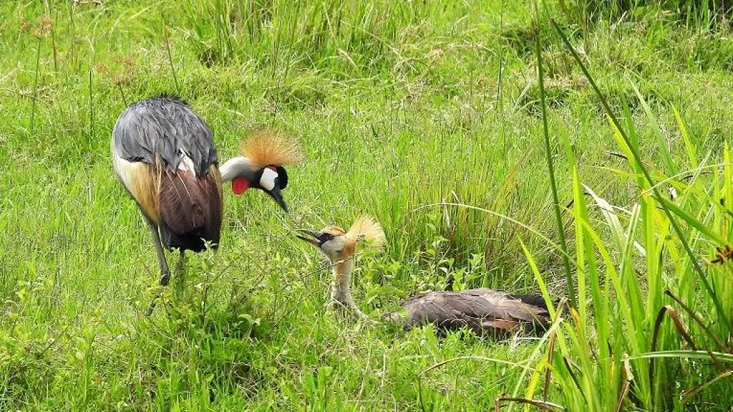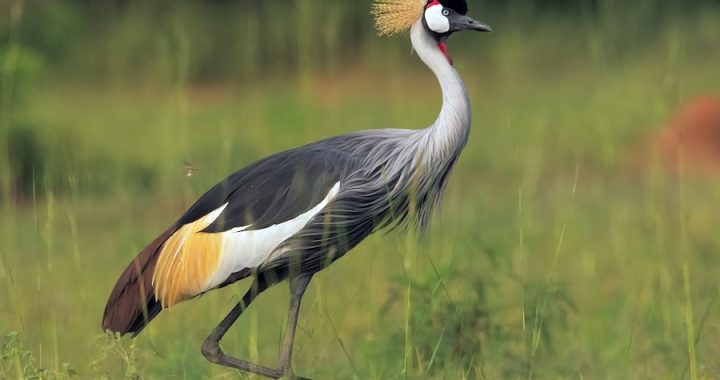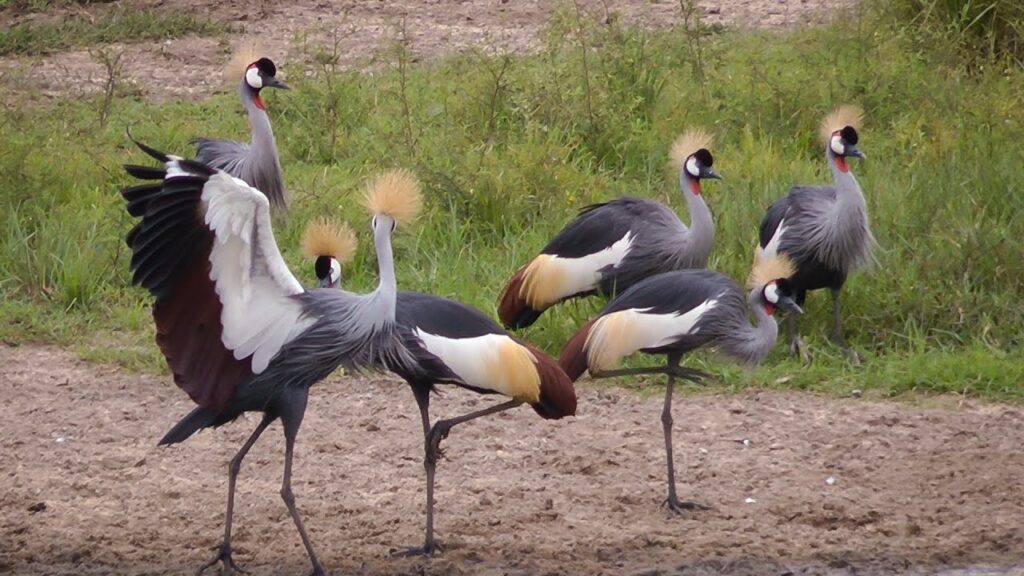Crested Crane
Crested Crane: Interesting Facts Regarding Uganda’s National Bird: Balearica regulorum is the scientific designation for the crested crane, also referred to as the grey crowned crane. It is an extraordinarily gorgeous bird characterized by a spectrum of hues and a remarkably fascinating mode of existence. The Grey-crowned Crane comprises two subspecies: the crested crane, classified as B. r. gibbericeps, which inhabits East Africa. This is prevalent across East Africa, especially in Kenya and Uganda, as well as in the eastern areas of the Democratic Republic of the Congo. The southern parts of Angola and South Africa host the B. r. regulorum, sometimes referred to as the South African crowned crane.

THE NATIONAL BIRD OF UGANDA
The grey-crowned crane is esteemed and constitutionally safeguarded as Uganda’s national bird symbol. Even young children recognize that it is a beloved national symbol that must be honored.
The bird was designated as the emblem of the Union Jack in 1893 by Sir Frederick Jackson, the then-governor of Uganda. His Majesty George V of England authorized its incorporation on the flags displayed by the Governor of Uganda. The crested crane is Uganda’s national bird due to its beauty and unassuming attitude. It is seen on all official state papers and the coat of arms.
PHYSICAL APPEARANCE
The grey-crowned crane is a sizable avian species that often reaches a height of 3 feet. It is nearly one meter in height. A typical crested crane weighs 3.5 kg. The head of a crested crane features a velvety black forehead, a yellowish (almost golden) crown, red neck pouches that expand, and white lateral areas. A linear, ebony beak finalizes the appearance.
Its elongated, grayish neck transitions to the body’s primary hues of black, white, red, and yellow. Long and slender legs were engineered to stabilize the torso. During your avian expedition to Uganda, you are sure to encounter the most vibrant and captivating bird.
NATURAL ENVIRONMENT
The crested crane is found exclusively in specific regions of Eastern and Southern Africa. While it favors nesting near damp areas such as riverbanks and marshes, it is generally located in arid, open environments.

Food and Diet
The crested crane is an omnivore species in its dietary habits. It can consequently ingest both flora and fauna as sustenance. Grass, seeds, insects, worms, rodents, flies, grasshoppers, tiny fish, and snakes exemplify plant life.
The crested crane preferentially consumes grass and sedge seeds, among various other foods. They dedicate their entire time to foraging for sustenance and resting in trees throughout the night.
Social Habit
The dance of the Crested Crane is widely acknowledged. At this juncture, it unfurls its splendid wings and commences to skip. The wings unfurl to vividly illustrate the harmonious blending of hues, notwithstanding the absence of a distinct pattern. Despite the feathers being white, the upper surface of the wings is black. Although they can dance year-round, this behavior is most commonly observed during the breeding season. It is indeed a spectacle to observe many of them “perform the dance.”
The crested crane may perch or stand on one foot, keeping the other close to its body when not foraging for food. It possesses a unique communication technique compared to Black-crowned Cranes. The call of the crested crane resembles a honking noise.
The crested crane exhibits monogamous social behavior, maintaining a singular lifetime companion. The male crested crane is consistently larger than the female, although the distinction may not be easily perceptible.
When not foraging along the riverbanks, they can often be seen in couples. Flocks of 30 to 150 birds are frequently observed around wetlands.
The Crested Crane can reproduce year-round in Uganda, although this occurs more commonly during the dry seasons. The extensive swamp grass and additional flora are utilized by crane pairs to construct large nests.
The female lays two to five dirty white eggs. Each spouse alternately incubates them for a duration of 28 to 31 days. The young are designated as chicks. The young of the crested crane can commence running immediately upon birth. Crested cranes can attain an average lifespan of 22 years.
STATUS OF CONSERVATION
The International Union for Conservation of Nature (IUCN Red List) categorizes the grey-crowned crane as an endangered species. Recent studies indicate a consistent decline in the population of these birds, potentially leading to their serious endangerment.

The global population of mature crested cranes is estimated to be approximately 22,000 individuals. In comparison to the 1970s, Uganda possessed far less of this. In 2011, Uganda hosted fewer than 10,000 grey-crowned cranes, a significant decline from 70,000 in the 1970s.
The diminishing natural habitat is a primary factor in the decreasing population. The crested cranes thrive in the Eastern and Southern African regions adjacent to inland marshes.
Wetlands have faced significant pressure from human activities, including agriculture and urbanization, because to the rapid population growth. The native habitat of the crested crane has been considerably reduced as a consequence.
